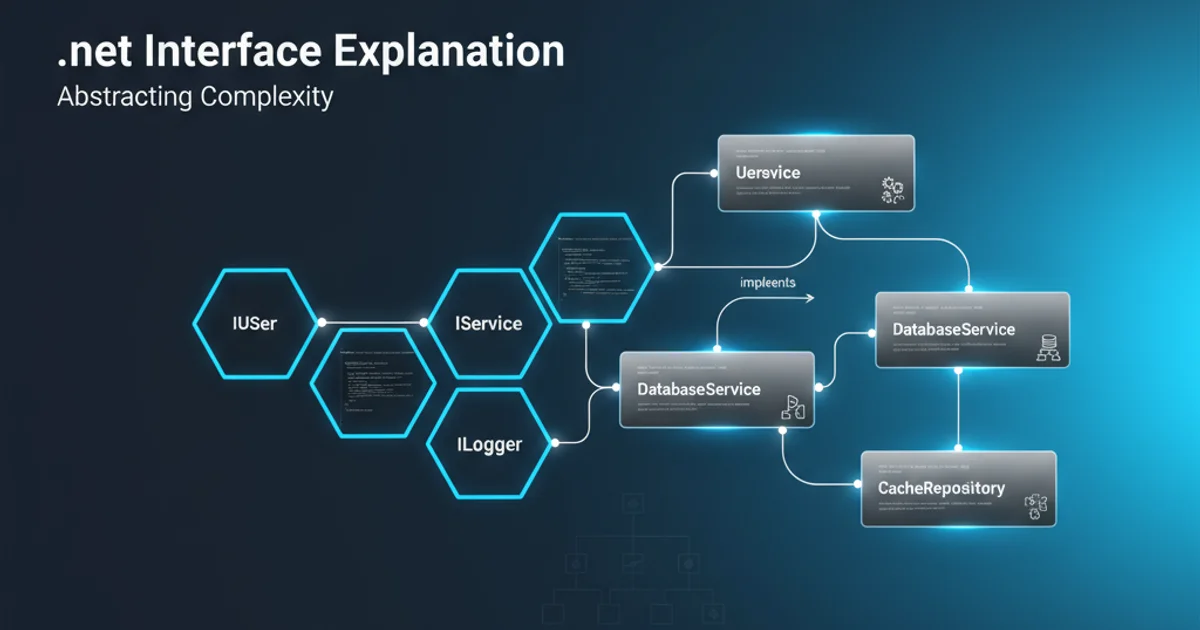.net Interface explanation
Categories:
Understanding Interfaces in .NET: A Comprehensive Guide

Explore the power and flexibility of interfaces in .NET, learning how they enable polymorphism, promote loose coupling, and enhance code maintainability and testability.
In the world of .NET development, interfaces are fundamental constructs that play a crucial role in designing robust, scalable, and maintainable applications. They define a contract that classes can choose to implement, ensuring a consistent set of behaviors without dictating the implementation details. This article will delve into what interfaces are, why they are essential, and how to effectively use them in your .NET projects.
What is an Interface?
An interface in .NET (and many other object-oriented languages) is a contract that specifies a set of public members (methods, properties, events, indexers) that an implementing class or struct must provide. It defines 'what' a class can do, but not 'how' it does it. Interfaces cannot be instantiated directly, nor can they contain fields, constructors, or destructors. They are purely abstract blueprints for behavior.
public interface ILogger
{
void LogMessage(string message);
void LogError(string error);
int LogLevel { get; set; }
}
Defining a simple ILogger interface
In the example above, ILogger defines a contract for any class that wants to be considered a 'logger'. Any class implementing ILogger must provide concrete implementations for LogMessage, LogError, and the LogLevel property.
classDiagram
interface ILogger {
+LogMessage(message: string)
+LogError(error: string)
+LogLevel: int
}
class FileLogger {
+LogMessage(message: string)
+LogError(error: string)
+LogLevel: int
+FilePath: string
}
class DatabaseLogger {
+LogMessage(message: string)
+LogError(error: string)
+LogLevel: int
+ConnectionString: string
}
ILogger <|.. FileLogger : implements
ILogger <|.. DatabaseLogger : implementsClass diagram showing how different loggers implement the ILogger interface
Why Use Interfaces?
Interfaces are powerful tools that bring several significant benefits to software design:
- Polymorphism: Interfaces enable polymorphism, allowing you to treat objects of different types uniformly as long as they implement the same interface. This means you can write code that operates on an interface type, and it will work with any class that implements that interface.
- Loose Coupling: By programming against interfaces rather than concrete implementations, you reduce the direct dependencies between components. This makes your code more flexible, easier to change, and less prone to breaking when one component's internal implementation changes.
- Testability: Loose coupling directly contributes to improved testability. You can easily substitute real implementations with mock or stub implementations during unit testing, isolating the component under test.
- Multiple Inheritance of Type: While C# does not support multiple inheritance of implementation, it does support multiple inheritance of type through interfaces. A class can implement multiple interfaces, thereby inheriting multiple contracts.
- Extensibility: Interfaces make it easier to extend your application's functionality. New classes can be added that implement existing interfaces without modifying existing code that uses those interfaces.
public class FileLogger : ILogger
{
public int LogLevel { get; set; }
public void LogMessage(string message)
{
Console.WriteLine($"File Log (Level {LogLevel}): {message}");
}
public void LogError(string error)
{
Console.Error.WriteLine($"File Error (Level {LogLevel}): {error}");
}
}
public class ConsoleLogger : ILogger
{
public int LogLevel { get; set; }
public void LogMessage(string message)
{
Console.WriteLine($"Console Log (Level {LogLevel}): {message}");
}
public void LogError(string error)
{
Console.Error.WriteLine($"Console Error (Level {LogLevel}): {error}");
}
}
public class Application
{
private readonly ILogger _logger;
public Application(ILogger logger)
{
_logger = logger;
}
public void Run()
{
_logger.LogMessage("Application started.");
// ... application logic ...
_logger.LogError("An unexpected error occurred.");
_logger.LogMessage("Application finished.");
}
}
// Usage:
// ILogger fileLogger = new FileLogger { LogLevel = 1 };
// Application app1 = new Application(fileLogger);
// app1.Run();
// ILogger consoleLogger = new ConsoleLogger { LogLevel = 2 };
// Application app2 = new Application(consoleLogger);
// app2.Run();
Implementing ILogger and demonstrating polymorphic usage
ILogger, IDisposable, IEnumerable). This clearly distinguishes them from classes and makes your code more readable.Explicit Interface Implementation
Sometimes, a class might implement two interfaces that define members with the same signature. To resolve this ambiguity or to hide interface-specific members from the public API of the class, you can use explicit interface implementation. This means the member is only accessible when the object is cast to the interface type.
public interface IControl
{
void Paint();
}
public interface ISurface
{
void Paint();
}
public class Button : IControl, ISurface
{
// Implicit implementation (publicly accessible)
public void Paint()
{
Console.WriteLine("Painting Button (default).");
}
// Explicit implementation for IControl
void IControl.Paint()
{
Console.WriteLine("Painting Button as IControl.");
}
// Explicit implementation for ISurface
void ISurface.Paint()
{
Console.WriteLine("Painting Button as ISurface.");
}
}
// Usage:
// Button b = new Button();
// b.Paint(); // Calls the implicit Paint()
// IControl control = b;
// control.Paint(); // Calls IControl.Paint()
// ISurface surface = b;
// surface.Paint(); // Calls ISurface.Paint()
Demonstrating explicit interface implementation